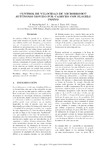Mostrar o rexistro simple do ítem
Control de velocidad de microrrobot autónomo movido por cabeceo con flagelo pasivo
| dc.contributor.author | Mancha Sánchez, Enrique | |
| dc.contributor.author | Serrano Balbontín, Andrés Joaquín | |
| dc.contributor.author | Tejado, Inés | |
| dc.contributor.author | Vinagre, Blas M. | |
| dc.date.accessioned | 2022-09-05T13:44:59Z | |
| dc.date.available | 2022-09-05T13:44:59Z | |
| dc.date.issued | 2022 | |
| dc.identifier.citation | Mancha-Sánchez E., Serrano A.J., Tejado I., Vinagre B.M. (2022) Control de velocidad de microrrobot autónomo movido por cabeceo con flagelo pasivo. XLIII Jornadas de Automática: libro de actas, pp.544-551. https://doi.org/10.17979/spudc.9788497498418.0544 | es_ES |
| dc.identifier.isbn | 978-84-9749-841-8 | |
| dc.identifier.uri | http://hdl.handle.net/2183/31471 | |
| dc.description.abstract | [Resumen] La robótica médica ha pasado de ser el futuro a estar entre nosotros en nuestro día a día. Existe una robótica médica más disruptiva, y con menos uso, por el momento, la microrrobótica. Existen multitud de aproximaciones a la hora de realizar un microrrobot. En este trabajo hemos realizado el modelo matemático inicial y el diseño de dos controladores para controlar la velocidad de un microrrobot autónomo movido por cabeceo con un flagelo pasivo acoplado. Mediante Simulink se han realizado estudios del modelo con distintos parámetros de entrada (simulando el empuje realizado mediante reacciones químicas) y el control de su velocidad. Se ha obtenido un modelo inicial que servirá de punto de partida para un modelo más completo. Además se realizó un prototipo funcional a escala. | es_ES |
| dc.description.abstract | [Abstract] Medical robotics has gone from being the future to being part of our daily lives. There is a more disruptive medical robotics, and with less use, for the moment, microrobotics. There are a multitude of approaches when it comes to making a microrobot. In this work we have carried out the initial mathematical model and the design of two controllers to control the speed of an autonomous pitch-driven microrobot with a passive flagellum attached. Simulink has been used to study the model with different input parameters simulating the thrust produced by chemical reactions) and to control its speed. An initial model has been obtained that will serve as a starting point for a more complete model. In addition, a functional prototype was made to scale. | es_ES |
| dc.description.sponsorship | Este artículo ha sido financiado por la Consejería de Economía, Ciencia y Agenda Digital de la Junta de Extremadura mediante el proyecto IB18109 y la “Ayuda a Grupos” GR18159, por la Agencia Estatal de Investigación mediante el proyecto PID2019-111278RB-C22 / AEI / 10.13039/501100011033, y por los Fondos Europeos de Desarrollo Regional “Una manera de hacer Europa”. | es_ES |
| dc.description.sponsorship | Junta de Extremadura; IB18109 | es_ES |
| dc.description.sponsorship | Agencia Estatal de Investigación; 10.13039/501100011033 | es_ES |
| dc.language.iso | spa | es_ES |
| dc.publisher | Universidade da Coruña. Servizo de Publicacións | es_ES |
| dc.relation.uri | https://doi.org/10.17979/spudc.9788497498418.0544 | es_ES |
| dc.rights | Atribución-NoComercial-CompartirIgual 4.0 Internacional (CC BY-NC-SA 4.0) https://creativecommons.org/licenses/by-nc-sa/4.0/deed.es | es_ES |
| dc.rights.uri | http://creativecommons.org/licenses/by-nc-sa/3.0/es/ | * |
| dc.subject | Microrrobótica | es_ES |
| dc.subject | Reacciones químicas | es_ES |
| dc.subject | Control de velocidad | es_ES |
| dc.subject | Microrobotics | es_ES |
| dc.subject | Chemical reactions | es_ES |
| dc.subject | Speed control | es_ES |
| dc.title | Control de velocidad de microrrobot autónomo movido por cabeceo con flagelo pasivo | es_ES |
| dc.title.alternative | Speed control of autonomous pitch-driven microrobot with passive flagellum | es_ES |
| dc.type | info:eu-repo/semantics/conferenceObject | es_ES |
| dc.rights.access | info:eu-repo/semantics/openAccess | es_ES |
| UDC.startPage | 544 | es_ES |
| UDC.endPage | 551 | es_ES |
| dc.identifier.doi | https://doi.org/10.17979/spudc.9788497498418.0544 | |
| UDC.conferenceTitle | XLIII Jornadas de Automática | es_ES |






